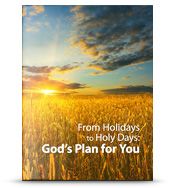Leap Day, Leap Months and Other Notable Times
Written by Mike Bennett
 Calendars are a representation of what is happening in space in the intricate dance of the sun, earth and moon. Some calendars are more accurate than others, and one in particular marks a whole different category of time!
Calendars are a representation of what is happening in space in the intricate dance of the sun, earth and moon. Some calendars are more accurate than others, and one in particular marks a whole different category of time!
I know a couple who got married on Feb. 29—Leap Day. They are coming up on their 15th anniversary—even though they have been married 60 years! Congratulations to Les and Marion McCullough!
Even if you weren’t born or married on Leap Day, I think the science behind leap years is kind of cool. The basic rule about Leap Day is to add one every four years, for example, this year, 2012. That’s because the year (the time it takes the earth to go around the sun) is about 365¼ days long.
But it’s actually not exactly a quarter. The year is 365.242190419 days long, so the leap year rules get a little more complex. Discover Magazine’s “Bad Astronomy” blog explains “Why We Have Leap Days,” with all the rules and all the math to prove that even with the current rules, another one-day adjustment will be needed every 3,200 years!
Solar calendars of Julius Caesar and Pope Gregory
 Leap Day was started in the time of Julius Caesar, when the best science of his day was used to determine that a day should be added every four years (the Julian calendar).
Leap Day was started in the time of Julius Caesar, when the best science of his day was used to determine that a day should be added every four years (the Julian calendar).
But over the centuries, the small discrepancy grew large, and by the 16th century the Julian calendar was 10 days off in marking the seasons. That’s when Pope Gregory instituted the new rules and dropped 10 days to get things back into alignment. This was the start of our current, Gregorian calendar. The British Empire didn’t accept the new calendar until 1752, when Wednesday, Sept. 2, was followed by Thursday, Sept. 14.
Lunar calendars
But calendars based on the sun aren’t the only calendars in use. The Muslim world uses a calendar based on the moon. It has 12 lunar months, which only add up to 354 or 355 days a year.
Since it is purely a lunar calendar, it is not synchronized with the seasons. That means Ramadan and other Islamic festivals will fall in different seasons over the years.
Imagine the challenge of combining a lunar and solar calendar!
Julius Caesar and Pope Gregory had a hard enough time trying to set a calendar just based on the sun. Imagine trying to combine the moon’s cycles into a unified calendar! There are about 12 lunar months (of about 29.5 days) plus 11 days per solar year.
 The Bible tells us God set the sun and moon and other heavenly bodies “for signs and seasons [‘seasonal signs,’ according to the Nelson Study Bible note on Genesis 1:14], and for days and years” (Genesis 1:14). The apostle Paul explains that God has given the “oracles of God” (Romans 3:2) to the Jews to preserve. Logically this would include the knowledge of the calendar implied in the Bible.
The Bible tells us God set the sun and moon and other heavenly bodies “for signs and seasons [‘seasonal signs,’ according to the Nelson Study Bible note on Genesis 1:14], and for days and years” (Genesis 1:14). The apostle Paul explains that God has given the “oracles of God” (Romans 3:2) to the Jews to preserve. Logically this would include the knowledge of the calendar implied in the Bible.
The Bible doesn’t give enough exact information for a reader to reconstruct God’s calendar. But it is clear that God does have a calendar, and that He has committed it to the Jews.
Leap months
In order to mesh the cycles of the sun and moon, the Hebrew calendar has leap months, instead of leap days. Seven years out of 19 have a 13th month. Leap years with the extra month occur in years 3, 6, 8, 11, 14, 17 and 19 of a 19-year cycle.
Months begin with the new moon; and because the average month is between 29 and 30 days long, the months can have 29 or 30 days.
How accurate is the Hebrew calendar?
According to Judaism 101, the average lunar month on the Hebrew calendar and the average lunar month calculated by modern astronomers are only different by “about half of a second. That is quite remarkably accurate.”
Divine appointments
This would all be just so much interesting trivia if God hadn’t made some time different from other time. It’s different in a way human instruments can’t detect, but it is different in a profound way that provides a portal to another dimension.
Like a school calendar, the Hebrew sacred calendar gives us the dates to be in class. It gives us our appointments with the Creator God who designed this incredible timepiece we call the universe!
These divine appointments are listed in detail in Leviticus 23. “These are the feasts of the LORD, holy convocations which you shall proclaim at their appointed times” (verse 4). The timing is important to God. And meeting together to learn from Him (the holy convocations) is important to Him too.
These festivals foreshadow specific events and times in God’s plan of salvation. These seasonal times teach us eternal truths! That’s why Jesus Christ and the New Testament Church continued to celebrate these divine festivals.
 Read more about these exciting times in the second half of our booklet From Holidays to Holy Days: God’s Plan for You.
Read more about these exciting times in the second half of our booklet From Holidays to Holy Days: God’s Plan for You.
Mike Bennett coordinates the blogs for cogwa.org. He and his wife, Becky, attend the Dallas, Texas, congregation of the Church of God, a Worldwide Association.
Related links:








